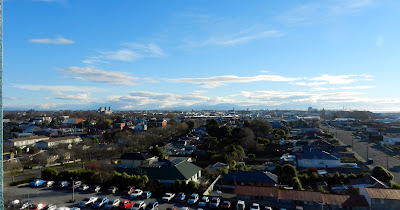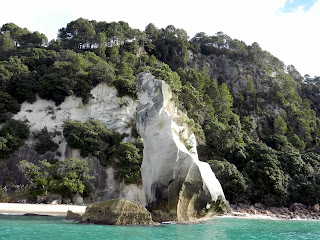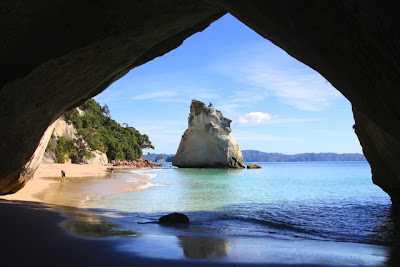Despite the characteristically cheerful forecast from the Timaru Herald, the Northerners were right. A few days earlier, Christchurch was blanketed in snow and the airport closed for a day. There was still a chill in the air and snow on the ground. This was our first visit to Christchurch after last year's tragic February 22 quake.
This was our first visit to Christchurch after last year's tragic February 22 quake. When we departed Timaru the end of February 2011 we planned to visit friends and leave via ChCh (as it is abbreviated here), but that was not an option. Renewing acquaintanceships with two ex-pat American families topped out priority list. Once more, we were treated to a delicious dinner at the home of Michele Dhanak (a doctor from the Bay Area), her daughter Savita, and her partner Howard. It is difficult to comprehend the stress and trauma these locals have experienced in the last year. They are still in the home we visited before, but like many homes it has not been completely cleared as fit, only deemed not in need of urgent abandonment and destruction. Since it is a rental, a decreased supply of homes has caused an increased demand and raised rents all over, and they fear that may force them to move.
 |
| Christchurch: City of Cranes |
It is easy to spot the 19th Century Heritage buildings, mostly made of brick with elaborate stone facades and spires: they are blocked off and destined for destruction or extensive and expensive rebuilding. The most famous and controversial of these is the most iconic structure in the center of town, the Christchurch Anglican Cathedral. After much soul-searching, the church officials decided rebuilding would not be feasible, and started the process of careful dismantling and preserving what they could, while soliciting ideas for constructing a new Cathedral.
 |
| Long view down to the cathedral |
There is significant local opposition, and as you can imagine it is a very emotional issue.
My feelings towards the current state of New Zealand's second largest city were mixed. The amount of destruction and ongoing uncertainty is tragic, but the evidence of the optimism and resiliency of locals is heartening. They have reopened some central businesses in brightly painted shipping containers in the "Re:Start Mall". |
| Re:Start Mall |
We were able to visit neighborhoods we didn't have time to visit previously, like New Brighton, a seaside resort noted for its pier and long stretches of sand. It was a beautiful sunny day.

 |
| Fun for the whole family |
 |
| View Back to Lyttleton from Governors Bay |
The story is that this was the first plane in the New Zealand Air Force, a gift of the UK, flown once by the only man in the country able to pilot it. He allegedly offended certain high officials by taking a comely young lass up for the first flight and not one of them, He was fired, and since no one else could fly it, it was dismantled and returned to sender.
Or the Sopwith Pup, the lesser-known cousin of the Camel.
The museum is also home to the longest-serving member of the RNZAF, the 75th squadron's mascot Flight Lieutenant Henry B. Fanshaw (Ret). Henry was on duty from WWII through 2001, when the 75th was disbanded, and had a very colorful history (see link).
 |
| Flight Lieutenant Henry B. Fanshaw (Ret.) |
.Other Ashburton attractions include the Giant Spinning Wheel (and craft shop)....
and the clocktower and "Love Me Tender" sculpture in the central square.
I wanted to make it to Timaru by Tuesday evening, when the senior doctors meet informally for dinner. I have learned to be cautious about re-visiting special places. Sometimes they seem not so special the second time around. But Timaru felt so familiar and comfortable, as if we had been away for a long weekend. It was great to visit my old work-mates at the hospital. We took a walk in the Botanic Garden, and passed another frequent garden stroller with her dog Sofie. She greeted us warmly asked where we have been. Even the proprietor of the Indian restaurant noted we hadn't been in a while. The view across the Canterbury plains from the hospital is still inspiring to me, although this is not the best photo.
We only had two more days in the South, and I decided to stop by two of my favorite near-by places: Mount Cook and Lake Tekapo. (Some of these photos will look familiar to followers of my first NZ blog.


 |
| Lake Tekapo |













































